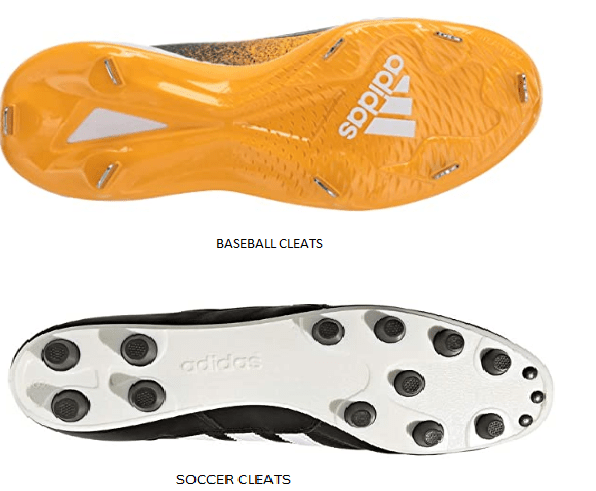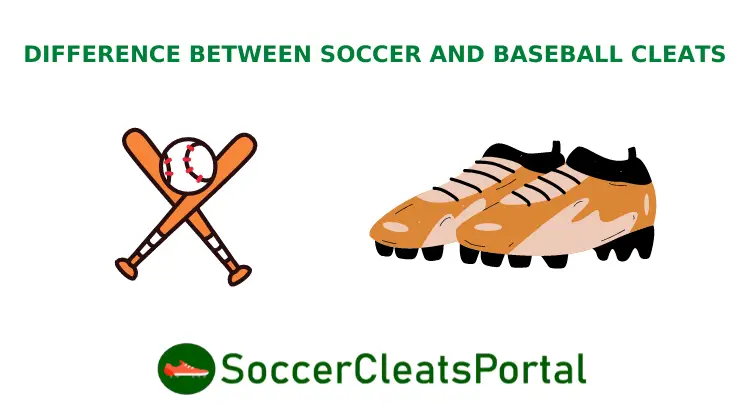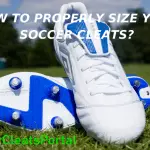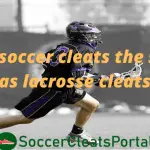Baseball and soccer cleats can be similar in many ways, and it can be difficult to differentiate them in terms of appearance. Using the right and appropriate shoes for the sport you’re playing is essential if you want to properly play the sport. What’s even more important is your safety when playing these sports.
The main difference between these two types of shoes is an extra toe stud that baseball cleats have while the soccer cleats don’t. Also, there are some manufacturing differences as the soccer cleats are lighter and basically low cut compared to baseball cleats.
A lot of people get confused about these two types of cleats. Read on and out below what’s the difference between baseball and soccer cleats.
Key Differences Between Soccer and Baseball Cleats
-
Toe stud
 The defining feature and main difference between baseball and soccer cleats is the toe stud.
The defining feature and main difference between baseball and soccer cleats is the toe stud.
Soccer cleats don’t have a toe stud because soccer involves a lot of running, and the stud may cause the player to fall and be injured. Baseball is a limited-contact sport, so safety measures can be a little more relaxed. Soccer is a full-contact sport, so there’s a higher risk for injury. Beside the safety reasons, soccer cleats do not have that extra toe spike as it could hamper the control and handling of the ball.
Baseball cleats have an extra spike on the toes. The extra spike gives the baseball player have extra jump leverage and traction. Players can dig easily into the ground and take off easily. There is a rubber toe guard in the front of baseball cleats because pitchers and catchers put a lot of pressure on the front part. The toe guard also adds durability to the cleats.
-
Stud length
At soccer cleats, the spikes are going to be a lot smaller than any other sport. The reason for that is that soccer is a sport that has a lot of change of direction and moving in different directions so you want to have as least resistance as possible.
Another reason for that is that you often step on the ball in soccer and you do not want lose the sensation of feeling the ball. The shorter cleats give the player more balance and safety while playing.
-
Outsole
The soleplate on soccer cleats is more pliable and thin, while in baseball cleats is made but hard plastic and has more rigid feel.
-
Midsole
The baseball cleats have a cushioned midsole that provides stability and comfort. You want to have thick midsoles for stability when swinging or pitching.
You don’t want to have a thick midsole in sports that involves a lot of running such as soccer. Soccer cleats have very little to no midsole for flexibility and lightness, especially when running.
-
Upper
Soccer cleats have a more rounded front area, which is called the striking zone, to give more control of the ball. The upper is more pliable and thinner to enhance the player’s feel and sense when touching the ball.
While in baseball cleats, the upper is bulkier and more rigid. It also has a rubber toe guard in the front, making ball control much more difficult. The function of the rubber guard is mainly for the durability of the cleats while the player is pitching.
-
Weight
A lot of footwork is involved in soccer than baseball. The cleats in soccer must be lightweight so that the player can move freely. The soccer cleats must be lightweight and supple to make the player run faster and safer.
In addition, the shoes in baseball are much heavier than soccer cleats because players don’t have to run around the track much often.
-
Ankle support
Soccer players need to run fast for a longer period of time than baseball players. In baseball, players do frequent running and sliding and they don’t need to run as much. Baseball cleats are available in the mid or high-top options with extra ankle support which adds extra weight. You don’t want to have heavier shoes in soccer because of all the running involved.
Soccer cleats are mainly low cuts because it allows the player to run faster and change the direction they are running easily.
Soccer cleats can also be similar with football and lacrosse cleats. I have written a different article with the difference between soccer and football cleats and one with the difference with lacrosse shoes.
Can You Wear Soccer Cleats for Baseball?
Rule 3.03(i) of the official baseball rules book says the following:
No player shall attach anything to the heel or toe of his shoe other than the ordinary shoe plate or toe plate. Shoes with pointed spikes similar to golf or track shoes shall not be worn.
So technically soccer cleats are allowed in baseball since there is not any rule to forbid them.
So you can wear soccer cleats for baseball, but don’t expect good performance. If you’re planning to play baseball for the long term, then baseball cleats are recommended. Soccer cleats can do for practice and exhibition, but if you’re aiming for the big leagues, better yet to invest in good baseball cleats.
Except for the performance, there is also the cost factor. Soccer is played by the feet, so the technologies and materials used in soccer cleats are more sophisticated in order to enhance the feel of the shoes and as a result the performance of the players. Especially with the higher-end soccer cleats, you are paying for those extra technologies that are not needed in any other sport. So you are wasting your money because a good portion of that cost is actually going towards unneeded functionalities.
Can You Wear Baseball Cleats for Soccer?
No specific mention is made concerning cleats or studs in the Laws of the Game (LOTG) put forth by the International Football Association Board (IFAB).
Law 04 pertains to players’ equipment and footwear; it states:
– A player must not use equipment or wear anything dangerous. (Section 1)
– Footwear is “compulsory equipment.” (Section 2)
Baseball cleats have an extra toe stud which can be considered dangerous in soccer. The extra toes stud can cause a player to fall and may cause an injury. Also tackling other players for the ball can become dangerous to them.
Referees always check the player’s shoes before the game starts or those who are going to come in as a substitute so that they are wearing appropriate shoes. It ensures that the game will be safe for all players.
Also, the same law above requires the referee to inspect each player’s equipment before the start of each match.
“The players must be inspected before the start of the match and substitutes before they enter the field of play. If a player is wearing or using unauthorized or dangerous equipment or jewelry, the referee must order the player to:
- remove the item
- leave the field of play at the next stoppage if the player is unable or unwilling to comply
A player who refuses to comply or wears the item again must be cautioned.”
So in professional soccer, you will probably not be allowed to wear them and even if you play recreationally you should avoid them for safety reasons.
Conclusion
So to sum this up here, one thing that I would recommend is going with a cheaper cleat for each sport rather than getting a higher-end cleat as this is going to be more specified to that sport so it will be less useful when playing other sport.
I would not recommend mixing baseball cleats with any other sport mainly because the rules don’t allow you to and also because baseball is just so different motion wise than any other sport. And finally the safety factor is much more significant for not playing soccer in baseball cleats.



